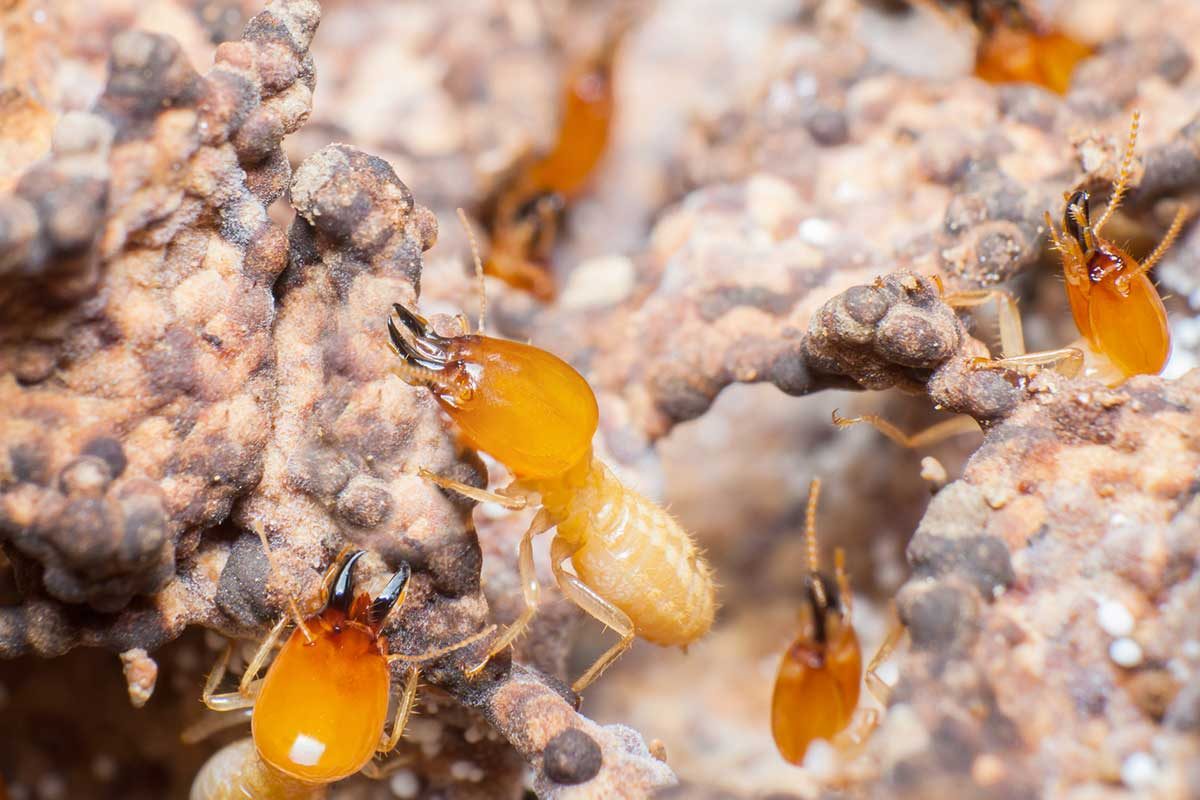Termites can be the bane of a property owner's existence. Learn how to keep these wood-munchers from eating you out of house and home.

Termites 101: Everything You Need To Know

Termites, like ants, are social insects that live in colonies. Dividing community labor between soldiers, workers and reproducers, termites sustain themselves by attacking and ingesting wood. Because wood is one of the most widely used building materials, it’s estimated that termites damage around 600,000 U.S. structures each year. And because homeowners’ insurance policies rarely cover termite damage, it’s believed that residents in the U.S. spend around $5 billion out of their pockets annually to repair the damage left behind by these invasive and ruinous pests.
To protect your investment from destructive termites, here’s what every homeowner should know with help from Danielle Restuccia, Division Technical Services Manager for Orkin’s Northeast Division.
On This Page
What Do Termites Look Like?
Often mistaken for ants, you can generally tell the difference between a termite and an ant by their straight waists and antennae, as well as by their white color or translucent exoskeleton. Winged (AKA swarming) termites have four equal-length wings, while ants’ wings are of different lengths.
What Are the Different Types of Termites?
The most common types of termites in North America are:
Subterranean
Considered the most destructive species of termites, they build their nests underground and burrow up into structures, often going undetected until you have a full-blown infestation. This species contains two subgroups: the Eastern Subterranean and Formosan. Both subspecies need to live underground where there is the moisture they need to survive.
Drywood
This species of termites builds small colonies inside dry pieces of timber. They eat silently, so they can go undetected in a home’s framing, hardwood floors and furniture for years.
How to Identify Termites
Keep in mind that a termite’s appearance differs depending on the type and species. For example, Drywood worker termites are a creamy color, while soldiers are slightly larger with darker heads. Formosan termites have orange bodies, and traditional Subterranean termites are more brownish in color.
Where Do Termites Live?
Of the more than 2,000 species of termites worldwide, about 50 of them can be found in the U.S.
Termites inhabit mostly warmer climates, which is why Alaska is the only state without them. They live in rural and urban environments, and can be found in homes, fences, sheds, garages, firewood and other dead wood.
“Homeowners might notice an accumulation of wings or frass (termite droppings) along baseboards and windowsills, bubbling paint or cracked interior walls or mud tubes on exterior walls,” Restuccia says.
What Do Termites Eat?
Termites eat wood, wood byproducts (paper, fabric, sawdust, wood chips, etc.) and other dead plants.
According to Ed Spicer, pest control specialist, the gut of a termite contains bacterial protozoa. “These protozoa break down cellulose, a biological compound found in wood, and create fuel from this unlikely resource,” he says. “Because cellulose is found most abundantly in wood and tree roots, termites gravitate toward it.”
Certain woods, like cedar, cypress and redwood, are naturally resistant to termites. Termites won’t bother pressure-treated and composite lumber, either. However, they will crunch through particleboard.
What Are the Signs That You Have Termites?
Termites are good at remaining hidden, consuming wood from the inside. They typically leave the skin of wood untouched, thereby concealing damage from the human eye.
Signs of infestation include:
- Mud tunnels (about the diameter of a pencil) on the surface of walls;
- Wood that sounds hollow;
- Blistering or uneven paint;
- Discarded wings;
- Feces droppings that look like sawdust;
- A swarm.
How To Treat Termites
“By the time homeowners notice a termite problem, it is often too late to try DIY solutions,” Restuccia says. “Calling a pest control company like Orkin is the only way to ensure termites are removed from a home and cannot cause further damage. There are no known safe and effective DIY treatments for termites, either. In fact, some common DIY solutions found on the internet can provide termites with more access to their favorite food sources (like using wet newspaper).”
Termite Safety and Concerns
Although termites can sting and bite, they aren’t toxic and don’t generally pose a health risk. Those allergic to termites’ saliva or droppings or who suffer from asthma could be affected.
What’s of most concern is the structural damage termites can cause. “Termites are a serious threat to our homes and must be immediately dealt with in the earliest possible stage of infestation,” says Spicer.
Once you determine that termites are present, it’s recommended that you contact a professional exterminator to help get rid of them as soon as possible. Every minute that termites are present is another minute of the destructive gnawing that can cost you thousands of dollars to remedy.
FAQ
How much does professional termite treatment cost?
Costs will vary depending on the severity of the infestation, the size of your home and the type of treatment. Monitoring and continual treatment will cost less than a full house fumigation to exterminate a severe infestation.
How long does it take for termites to cause serious damage?
While visible damage occurs within 6 months, serious structural damage will take several years to develop.
About the Expert
- Danielle Restuccia is Division Technical Services Manager for Orkin’s Northeast Division.
- Ed Spicer is a pest control specialist with many years of experience in the industry.




















